Question from Carly M.:
Dear Geek,
This may seem silly, but did Isaac Newton really invent the cat flap door?
Thanks,
Carly
Author: Invention Geek
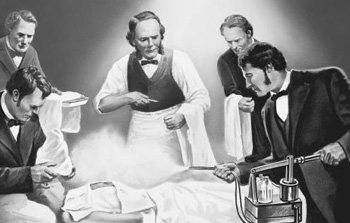 Joseph Lister helped make surgery a much safer undertaking. Before Lister’s discovery, surgery was a last resort because of the high rate of post-operative infections. People believe that it was bad air in a hospital that caused infections after surgery. Preventative measures to prevent infections and diseases included airing out a hospital during the day.
Joseph Lister helped make surgery a much safer undertaking. Before Lister’s discovery, surgery was a last resort because of the high rate of post-operative infections. People believe that it was bad air in a hospital that caused infections after surgery. Preventative measures to prevent infections and diseases included airing out a hospital during the day.
Pasteur’s research which showed that the presence of micro-organisms caused rotting and fermentation was the basis for Lister’s research to make surgery safer. Pasteur suggested three ways to eliminate these organisms. One of these methods was exposure to chemical solutions.
Carbolic acid, a chemical which was used to deodorize sewage, was Lister’s chemical of choice. In August of 1865, Lister experimented with the chemical on the leg fracture of an eleven year old boy. He applied bandages dipped in carbolic acid to the leg wound. He removed the first bandages after four days and there was no sign of infection. After continuing to dress the wound with carbolic acid for six weeks, the boy’s leg healed perfectly with no signs of infection.
Continue reading “The Father of Modern Antisepsis”
Question from Fabi R.:
Dear Geek,
I stumbled onto patent #1120656 the other day, and it looks like the pushpin (thumbtack) we buy & use today. Do you know if this was the original pushpin? And could you, anyway, tell me if not which one was and how did they came up with the idea?
Thanks, Geek!
Sincerely,
Fabi
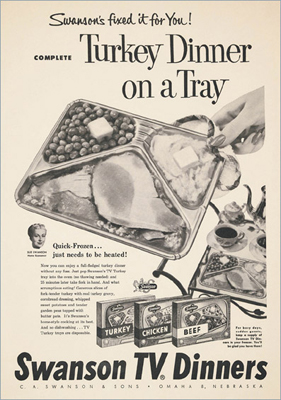 When Swanson introduced the TV dinner in 1954, it was an instant success. The frozen meal fit in perfectly with the nation’s obsession with prepackaged, convenience foods and a growing love of the television. At a price of 98 cents, the first meal sold was basically a Thanksgiving dinner with turkey, cornbread dressing, peas and sweet potatoes. Swanson hoped to sell about five thousand dinners the first year. Instead, sales hit more than 10 million.
When Swanson introduced the TV dinner in 1954, it was an instant success. The frozen meal fit in perfectly with the nation’s obsession with prepackaged, convenience foods and a growing love of the television. At a price of 98 cents, the first meal sold was basically a Thanksgiving dinner with turkey, cornbread dressing, peas and sweet potatoes. Swanson hoped to sell about five thousand dinners the first year. Instead, sales hit more than 10 million.
Although there were many frozen prepackaged meals before the Swanson’s TV dinner, none were as successful as Swanson’s in its aluminum three-compartment tray ready to be cooked at 425 °F for 25 minutes. Like many food inventions, the actual inventor of the Swanson’s TV Dinner is questionable. Gerry Thomas, an executive at Swanson, claimed he invented the frozen meal. But this claim has been disputed in recent years by other Swanson employees and Swanson family heirs. They claim the product was invented by the Swanson brothers, Clarke and Gilbert.
There are many accounts as to how Thomas formulated the idea for the TV dinner. In one story, the dinner was produced to use a large surplus of frozen turkeys which resulted from poor Thanksgiving sales. Another story is that inspiration for the meal came aboard a Pan Am Airways flight. The three-compartment aluminum tray was fashioned after the a tray in which a in-flight meal was served. Supposedly, the name for the meal did not come from the idea of eating the dinner in front of the television. Thomas designed the packing to resemble the front of a TV set with the inset screen and the rotary knobs. Continue reading “TV Dinner Controversy…”
Question from Joyce P.:
I saw a motorized pogo stick on Auction Kings. What can you tell me about this crazy invention?
Hello Joyce,
The owner of a tool and die shop in Elwood, Indiana, Gordon Spitzmesser, invented this pogo stick which was basically a small gasoline motor by combining the barrel of a grease gun with a lawnmower piston. Bouncing pushed the piston in the cylinder, compressing the file and firing a sparkplug which would cause the stick to launch into the air. The average bounce was about 30 inches high.
Spitzmesser applied for a patent on January 10, 1958. He was issued U.S Patent 2,929,459 on March 22, 1960 for a Combustible Gas Powered Pogo Stick.
Chance Manufacturing, an amusement ride manufacturer, purchased the patent rights from Spitzmesser. Chance sold the invention in the 1960’s as the “Hop Rod.” Ultimately, the toy was banned after too many people were injured in accidents involving the hopping stick. Today, there are very few left in existence and I am certainly not rushing to try one out.
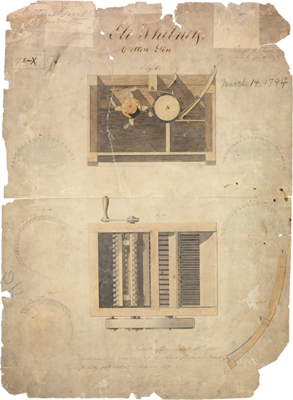 An invention can be so valuable as to be worthless to the inventor. Eli Whitney came to this conclusion because of the financial failure that was the cotton gin. Whitney gained fame and notoriety from his invention but did not gain the wealth he had anticipated.
An invention can be so valuable as to be worthless to the inventor. Eli Whitney came to this conclusion because of the financial failure that was the cotton gin. Whitney gained fame and notoriety from his invention but did not gain the wealth he had anticipated.
The cotton gin is a mechanical device that removes seeds from cotton. Before the invention of the gin, seeds had to be removed by hand. The cotton gin was a wooden cylinder with wire teeth. The teeth grabbed the cotton fibers and pushed them through a grate. The seeds were too large to fit through the grate so they were pulled away from the fibers. Whitney’s cotton gin could clean about 55 pounds of cotton a day.
The invention of the cotton gin changed the cotton industry in the United States. Whitney gave a one-hour demonstration of his new invention and farmers were ecstatic. They could now plant green seed cotton and remove the seeds much quicker and effectively.
Whitney did receive a patent for his cotton gin on March 14, 1794. This patent would later be numbered as X72. Whitney and his partner, Phineas Miller, did not actually intend to sell their product. They were planning to charge farmers for the service of cleaning the cotton. Their large price, two-fifths of a farmers profit, paid in cotton was the beginning of their financial problems.
Question from Gary L.:
I think the drive-through is one of the best inventions ever. I love that I can get food and coffee without ever having to get out of my car. Who should I thank for this wonderful convenience?
Hello Gary,
The first drive-up window was actually not at a fast food restaurant. The first window was added to the City Center Bank in Kansas City, Missouri. Bank president. R. Crosby Kemper opened this window in 1928.
The idea of a drive-through window was not translated to a restaurant until twenty years later. In-n-Out Burger claims that they built the first drive-through restaurant in 1948. The restaurant, in Baldwin Park, CA had an intercom system so customers could order without ever getting out of their cars.
Today, drive-through windows can be found everywhere from restaurants, coffee shops and banks to drug stores, funeral homes and wedding chapels. Next time, you enjoy the convenience of the drive-through you should thank Harry and Esther Snyder, the founders of In-n-Out Burger.
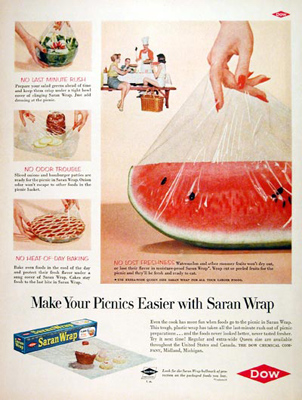 Saran wrap is another product which can be added to the list of accidental inventions. Ralph Wiley was not even working as a scientist when he discovered the substance that would become Saran wrap.
Saran wrap is another product which can be added to the list of accidental inventions. Ralph Wiley was not even working as a scientist when he discovered the substance that would become Saran wrap.
In 1933, Wiley was working in a laboratory at Dow Chemical cleaning glassware when he found polyvinylidene chloride, the chemical that would later become Saran Wrap. He came across the substance in a vial that he could not scrub clean. Wiley called this chemical “eonite” after a material in the Little Orphan Annie comic strip.
Wiley applied for a patent on July 1, 1936. He was granted US Patent 2,160,931 on June 6, 1939 for
Co-Polymerization Products.
Researchers at Dow turned eonite into a greasy, dark green film. The product was not originally used to wrap food. The substance was used first by the military to protect fighter plants against salty sea spray and then carmakers used it for upholstery. It was not until Dow created a version without the smell and green color that it was used for food protection. Continue reading “Yes, Saran Wrap Was An Accident Too…”
Question from Carrie:
I was listening to Jimmy Buffet’s song “This Hotel Room” and one of the lines is- “Feel alright, feel alright. Magic Fingers makes you feel alright.” I remember hearing that Magic Fingers was popular in motels a while back. Who invented it?
Hey Carrie,
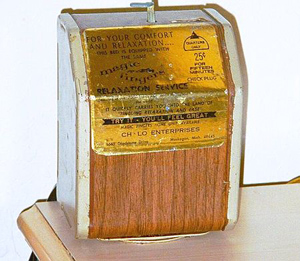 John Houghtaling invented Magic Fingers in his New Jersey Home in 1958. He received patent 3,035,572 for a vibrator on May 22, 1962.
John Houghtaling invented Magic Fingers in his New Jersey Home in 1958. He received patent 3,035,572 for a vibrator on May 22, 1962.
Magic Fingers was a vibrating bed relaxation system found in many motels during the 1960s and ’70s. It was installed onto millions of beds and in exchange for a quarter, the bed would provide 15 minutes of vibrating relaxation. The device was marked by a label reading; “Magic Fingers quickly carries you into the land of tingling relaxation and ease.”
Houghtaling was a salesman for a company that sold vibrating beds. The bed and the vibrating motor were sold together as a single item. While fixing a broken unit, Houghtaling realized that the vibrating motor was the most essential element and not the bed itself. He wanted to design a vibrating unit that could be attached to the box spring of any bed. He tested about 300 motors before finding the right combination that was light in weight and made the bed vibrate at a comfortable frequency.
At the height of its’ popularity, Magic Fingers collected about $6,000 to $7,000 a month in quarters.
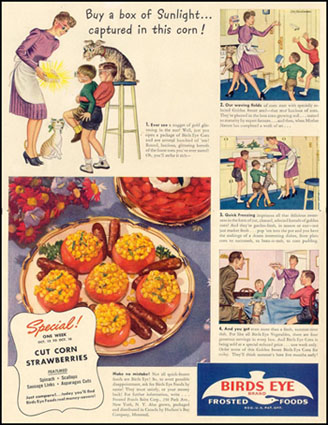 As a young adult, struggling to financially support himself through Amherst College by catching and selling frogs to the Bronx Zoo, Clarence Birdseye would later come into a great fortune within the food industry and be named ‘The Father of Frozen Food.’
As a young adult, struggling to financially support himself through Amherst College by catching and selling frogs to the Bronx Zoo, Clarence Birdseye would later come into a great fortune within the food industry and be named ‘The Father of Frozen Food.’
In 1912, Birdseye went on a fur-trading expedition to the Canadian province of Labrador when he realized that there was a fortune to be made in breeding and trapping foxes. He did just that for the next five years. He also did a fair amount of fur re-sale. Food supply in secluded parts of Labrador were little, so he ate things such as blackbirds, whale, lynx, lizards, starlings, alligator, beaver tail and skunk.
Birdseye was taught how to ice fish under thick ice by the native Inuit people. Once caught, he realized the fish froze almost instantly and when thawed, tasted fresh. Birdseye saw the preservative effects of extremely cold temperatures on fresh fish. He realized that this ‘fast freezing’ method could develop into a great way for people to have access to fresh food all year-round. Continue reading “The Father of Frozen Food”
